Date: 11/12/2014
Starting Location: Pucon, Chile
Ending Location: Bariloche, Argentina
Mileage Today: 234 Miles (377 Km)
Mileage Total: 301 miles
EoD Odometer Reading: 13,543
The morning departure
It was an early morning in Pucon, rising at 5:00 in order to get packed, get a little breakfast, get the truck loaded and ready to leave by 7:00 AM. We left on time, and within an hour we were within striking distance of the Argentine border, but perhaps because this is South America, or perhaps because it’s an adventure trip, we were about to have a few little road blocks thrown at us.
Oh, you thought I was using a metaphor. Nope, I’m afraid that by 8:00 we had come to an actual road block, which caused the road to be completely shut down for 3 hours. It seems that the Chileans have this really beautiful stretch of road, and they wish it to be an even more beautiful stretch of road. So, they started a few projects to “improve it”.
The road block remained in effect until exactly 11:00 AM, at which time the guard allowed us to begin the 10 mile to the Chilean border control point.
Today’s Ride
From the roadblock, we headed towards the border between Chile and Argentina. I’ve crossed many borders in my years on this planet, but this is the first time that my border crossing was not at an airport. As you might imagine, border crossings away from airports are a bit different.
The road to the border
The 15Kilometers (10 miles) from the road-block to the border was dirt road. In addition, although they had opened the control point at 11:00 AM, the trucks were still performing their work, and as we rode towards Argentina, we were confronted with giant dump trucks, and other bits of heavy equipment, all of which seemed to show up just as I was approaching some gravel, on a turn, after a run of some spirited driving.
Over the 10 miles, we came on mostly hard packed road, with loose dust and dirt on the top. More than 90% of this road is corrugated, covered with undulations, which tend to cause the bike to vibrate a whole lot. This undulating terrain can be tough to ride on, but even more difficult is the sections with deeper gravel.
The first time I came on one of these bits of gravel I was standing on the foot-pegs, travelling at about 55 Mph, all of the sudden, the whole bike started to float around underneath me, as if the devil himself had placed thousands of banana peels on the road. When this happens, the proper technique is to reposition your body, leaning back over the rear wheel, allowing the front wheel to become lighter, so that it can dance over the gravel.
Those of you that have seen me dance can only hope that I’m more skilled when I dance with the bike than I am on the dance floor. If I were to dance on the gravel, as I do at weddings, I would have certainly met my demise. But, as it turns out, I really can dance with the bike, and I really can’t dance on the dance floor.
In preparation for this trip, I have spent numerous hours, dollars, and miles trying to establish a skills base. I attended 2 of the famous Doc Wong clinics at Clear Creek, a 2 1/2 day course at Rawhyde in Castaic, CA, and traveled to Northern Sonoma, where Bruce and I, along with a few others
The Chilean Crossing
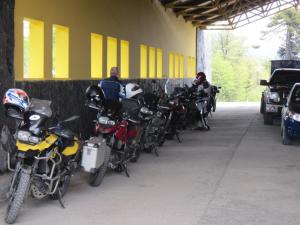 We arrived at the Chilean crossing with a great deal of excitement at about 11:20 or so. The trip from the road block was a dirt road, with mixed conditions. We arrived at the border with little fanfare, and because we were the first people to exit the road-block, and because we were moving along the dirt at a brisk pace, we were the first to arrive at the checkpoint. We quickly organized ourselves, and set out to get through Chilean Immigration, and Chilean Customs.
We arrived at the Chilean crossing with a great deal of excitement at about 11:20 or so. The trip from the road block was a dirt road, with mixed conditions. We arrived at the border with little fanfare, and because we were the first people to exit the road-block, and because we were moving along the dirt at a brisk pace, we were the first to arrive at the checkpoint. We quickly organized ourselves, and set out to get through Chilean Immigration, and Chilean Customs.
Back on the 7th of November when I arrived in Santiago, I was given a very important piece of paper, which would be needed when I tried to leave Chili. In true adventure fashion, I apparently lost this “really, really important” piece of paper. I had previously informed Eduardo and Alain that “it appears that the folks at Chilean Immigration had taken this piece of paper from me when I exited the Immigration control point in the airport”.
Eduardo and Alain were a bit skeptical, but just they handled it just as any good Adventure guide would. They said, don’t worry, we’ll sort it out at the border crossing. So, here we are, 4 days later, and now I’m at the border crossing. I walked up, beaming my best American smile, and with a healthy dose of Buenos Dias, and Hola’, I handed over my passport, and the credentials for the motorcycles. Flashing a nice Chilean smile back at me, he seemed to be asking me for something that I had not provided to him. After indicating that I did not speak Spanish (No hablo Espanol), he indicated to me that I would have to return to Santiago, in order to get the proper paperwork.
Now, I don’t need to remind you that Santiago is a 90 minute drive, followed by a 1 hour plane trip from where I was. So, we needed another plan. I called over to Eduardo for help, and stood in place in the line, even though I was unable to do anything to improve my current condition.
Eduardo took over. Asked me what happened, and under his breath, indicated that I should say that I lost the paper. I nodded, and from here, things got a little fuzzy, but as near as I can make out, Eduardo told them that I’m an absent minded American, and was not careful with my paperwork, and had lost it, at some unknown place, several days ago.
It worked perfectly, and in a matter of seconds, I was able to fill out another form, and with all the pomp and circumstance you might expect, a convincing thud of the proper bureaucratic thud came as the stamp was placed on the form, and then in my passport. We had done it, I had immigrated out of Chile. The next booth over was customs, which went very quickly, and just like that, we were done, and ready to go. That’s it, 20 minutes, in and out. Within about 30 minutes in total, our whole group had cleared Immigration and received the proper stamps on the temporary import paperwork for the bikes.
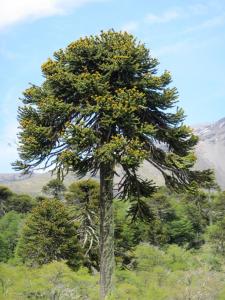 Waiting outside of the border control point, we had a chance to take some pictures of the view from the station. Although this is a remote outpost, and i can’t help but believe that you’re a civil servant for Immigration or Customs, this is not the ideal place to be assigned, nevertheless, the views are breathtaking, and interesting. From the station, we had an awesome view of the mountains and of what we thought was a type of tree called “the monkey puzzle tree”. But, who knows, I’m in high-tech, and I can’t be expected to know, or even care about everything, right?
Waiting outside of the border control point, we had a chance to take some pictures of the view from the station. Although this is a remote outpost, and i can’t help but believe that you’re a civil servant for Immigration or Customs, this is not the ideal place to be assigned, nevertheless, the views are breathtaking, and interesting. From the station, we had an awesome view of the mountains and of what we thought was a type of tree called “the monkey puzzle tree”. But, who knows, I’m in high-tech, and I can’t be expected to know, or even care about everything, right?
Now, it’s time to drive the short distance to Argentina. Or is it?
You really have to hand it to bureaucrats. They are exceptional at creating obstacles, for no apparent reason. And such was the case with us. Within minutes, Alain reported to us that there was “a minor issue with the paperwork for the truck” but that it would be “sorted out, straight away”. To say that Alain is an optimist is an understatement. Always with a smile and kind word, he let us know that we should be ready to shortly.
Sorry Alain, that’s not how it’s going to work today. After another 2 1/2 hours of searching the Internet, Satellite phone calls to Australia, and numerous forms, we were told that we could pass, and were free to go.
The Argentine Crossing
If you’re like me, and have never crossed a border at a remote outpost, you’re not really sure how they work. So, let me explain…
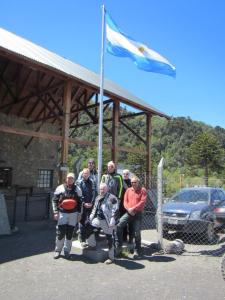
Our little group of riders, posing for a picture beneath the Argentine flag, at the border crossing.
The Argentine border control point is about a mile or two from the Chilean control point. The area in-between is considered to be no mans land, and is not under the control of either country. So, after leaving Chile, we drove through no-mans land, and arrived at the Argentine crossing a few minutes later.
Alain and Eduardo were quite nervous about this crossing. Apparently the Argentine government is very concerned about the black market for motorcycle parts, and they want to be sure that they extract their pound of flesh, known in the free world as duty.
Right on queue and just as expected, the police, and the customs agent followed Eduardo out to the truck and began to ask some tough questions. To everyone’s surprise, and apparently the result of a clever and creative way of explaining that all of these spare parts are to service the bikes, in the event of a problem, we were told “Ok to pass, no problem”. So, with all of the riders and passengers having already completed their immigration and customs work, off we went, into Argentina
Riding the bike on dirt roads in Patagonia
I think that people that don’t ride big Adventure bikes off-road can have a pretty radical misunderstanding of the complexity of this type of riding. These bikes weigh more than 500 lbs, and a fully loaded BMW R1200 GSA can weigh almost 700 Lbs. So, these things are not to be trifled with.
Most of our group is riding F700 GS bikes, and I’m riding an F800 GS. These bikes do not have panniers (luggage) attached to them, and because the engine is smaller, they probably weigh about 500 Lbs, plus the weight of the rider.
Riding one of these large bikes on dirt, or through mud or gravel can be tricky, to say the least. There are several important techniques and tactics that you have to know to be successful, but most important is that you need to have put in some miles on dirt in order to be comfortable. No matter what your skill level, or the types of riding that you’ve done in the past, you’ll need to take a certain amount of time to get comfortable.
I had ridden almost 200 miles off-road prior to joining this trip. While that is not enough to make any statement about my skill, the important point is that I had already had numerous days of riding in dirt, and had fallen twice in the Rawhyde training, and once recent while riding in Sonoma. So, I’ve lost the fear and most of the apprehension that can come from riding dirt with a big bike, and now I’m able to ride with confidence, and with that confidence, comes the calm and control that you need when you’re going to let the bike dance underneath of you.
I’ve included a little bit of video that will take you from the Argentine border, as we exit, over about 10K of dirt, to a regrouping point at the edge of the pavement. You’ll notice that at bout the halfway point, I slow down considerably, and if you look carefully, you’ll see the bike start to move around underneath me. Each time I hit gravel, this is the sort of thing that would happen. You have to quickly adjust your speed to maintain control, and then ride through it with your weight on the rear of the bike.
Some of the guys in our group have a lot of experience with off-road riding, while others done. So, the guys that don’t have a lot of experience are going through that same process of getting familiar with the dirt, and each time we ride the dirt we can see their confidence building, along with their skills.
It does need to be said that while these guys may not have a lot of experience in the dirt, they are really quite good on the tar sections. As I was riding last night, I found that Jay was really fluid and confident on the tar, while just minutes before, he was maintaining a more conservative pace in the dirt. So, each of us has the set of skills that we have, and that’s all that we have.
Today’s dirt ride had us riding in some gravel that was tricky to negotiate, but I’m told that the upcoming gravel is going to be “100% worse”. I guess I’m not exactly what that means, but you’d have to be an idiot not to understand that it’s going to be worse, and to treat it with respect.
S.H.I.T.
The affect of the Southern Hemisphere on International Travelers
In California, the days are getting shorter and shorter, and we’ve just gone through the Semi-annual changing of the clocks that signifies the change away from Daylight savings time. All of this means that the sun comes out at about 7AM, and is gone by about 5:30 PM. To me, that’s just not fair. We need more sunlight, but we’re powerless to change it. Or are we?
Here in Argentina, summer is just beginning, and as a result, those in Chile and those all across the Southern Hemisphere are enjoying the days and nights being longer. For someone on an adventure holiday, having longer days is a real blessing. Just imagine that you’ve had some troubles during the day, and you’re going to have to ride after 6PM in order to get to your final destination. Never-mind the challenges that you’ve faced during the day, never mind the exhaustion that you might be dealing with, and never-mind all of the hard-to-imagine bureaucratic obstacles that you might have faced, the last thing that you want to face is having to ride at night, in a strange country, on unknown roads, in the dark.
So, as an Adventure traveler (yeh, I know, this is actually my first trip, but give me a break here), I fully subscribe to this line of thinking, although my periodic episodes and bouts of over-confidence can cause me to forget this on occasion.
Yesterday, we had a very long day, and throughout the whole day, we were growing more and more concerned that we would end up riding in the dark. Imagine that it’s after 8:00 PM, and you’re still 50 kilometers from your destination, and the sun is about to set. For sure, this can weigh heavy on your mind, so when it happens (When I say it, I mean S.H.I.T.), you have to refocus your energy, and maintain the arrival as your number one objective, doing whatever is necessary to avoid riding at night.
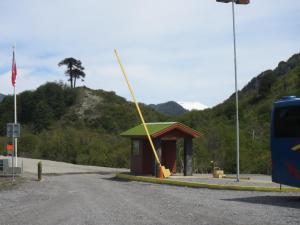
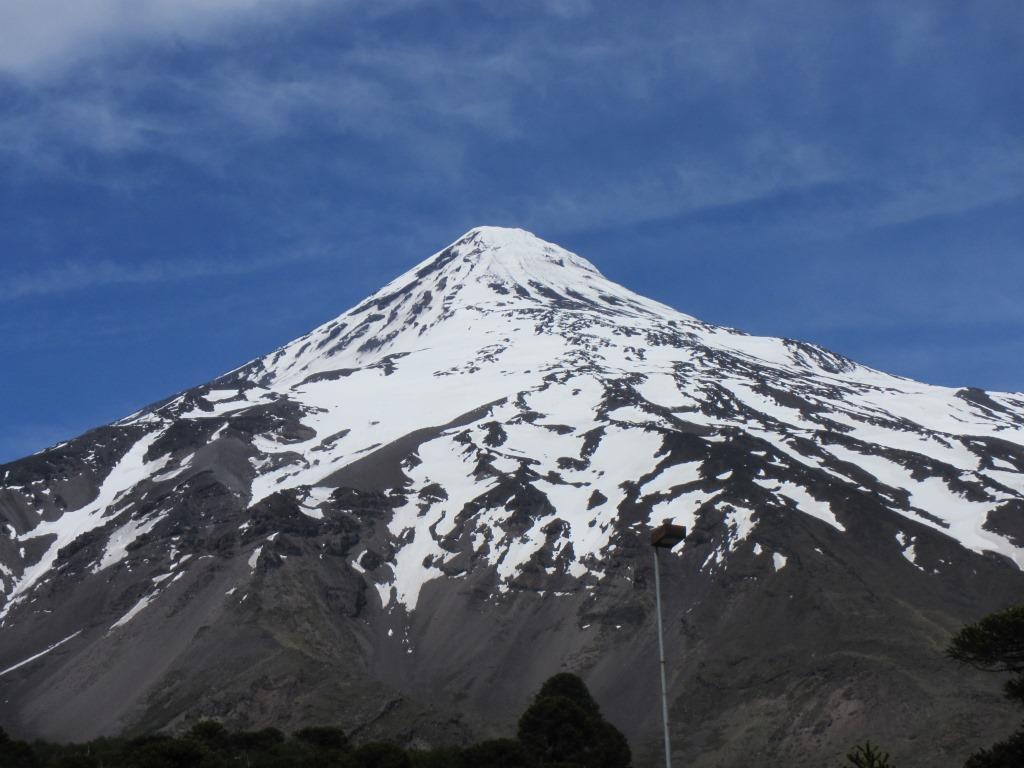
Hi CJM
very cool helmet cam, too bad you didn’t know enough about computers to make that a live feed
so we can check in on you during the day
wouldn’t that be cool?
I know what to get you for Christmas, a bag of gravel
keep up the good work
CDM
Carl,
The way that I’m looking at it is that a bag of gravel is much better than a bag of coal, which is what you threatened me with last year. So, I see this as a positive.
Wow, the helmet cam is so much better than the prior mount to the bike fairing, nice!
The screen mounted to the handle bars, a GPS device…. is it proving to be helpful and accurate?
How about a screen shot of your relative position on the map? Elevation, temperatures, humidity, etc.
This is great, having eyes in Argentina! Best wishes finding coffee, the internet, and good food along the way.
Larry
Hi Larry,
Yes, I’m fully embracing all of the tech wizardry that money can buy. It is a bit of a project to try to get all of this stuff operating, and to keep it fully charged each day. Especially when you consider that I’ve had to bring a number of different adapters (3 for Chile, and 4 for Argentina).
I would love to be able to show relative position on a map, but as it is, these blog posts take up quite a bit of time, especially rendering the video. Last night’s video took 6 hours to upload to YouTube. Remember, I’m in the 3rd world.
Was starting to go through a bit of ‘Cliff’ withdrawal and was very happy to see today’s posts.
Keep them coming!!!
Hey Cliff,
It looks like you’re having what scooter riders call “fun”. I’ve been riding some sort of scooter for 55 years (that’s a scary thought) and that includes road, flat track, motocross, and dirt riding in the woods. When in New Mexico, the bride and I saw a lot of dirt trails and I told her then we needed to try that out one day. I’m not sure she’s ready for that…keep it vertical.
Fred